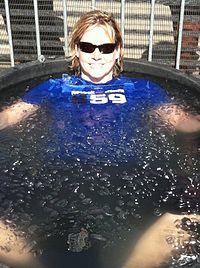
Photo from wikipedia
OBJECTIVES To assess the effects of hydration status and ice-water dousing on physiological and performance parameters. DESIGN Randomized, crossover. METHODS Twelve athletes (mean[M] ± standard deviation[SD]; age, 20 ± 1 years; height, 174 ± 8 cm; body mass,… Click to show full abstract
OBJECTIVES To assess the effects of hydration status and ice-water dousing on physiological and performance parameters. DESIGN Randomized, crossover. METHODS Twelve athletes (mean[M] ± standard deviation[SD]; age, 20 ± 1 years; height, 174 ± 8 cm; body mass, 72.1 ± 11.0 kg; VO2max 53.9 ± 7.3 mL⋅kg-1⋅min-1) completed four trials (euhydrated without dousing, hypohydrated without dousing, euhydrated with dousing, and hypohydrated with dousing), which involved intermittent treadmill running (five 15-minute bouts) in the heat (M ± SD; ambient temperature, 34.7 ± 2.1 °C; relative humidity, 46 ± 3%; wet-bulb globe temperature, 28.0 ± 0.4 °C). Participants also completed four cognitive, power, agility, reaction time, and repeated sprint performance tests throughout each trial. Heart rate (HR) and rectal temperature (Trec) were measured continuously. Repeated measures ANOVAs were performed to assess differences between physiological and performance variables. Alpha was set at ≤0.05, a priori. Data are reported as mean difference ± standard error (MD ± SE). RESULTS HR was significantly lower in euhydrated trials compared to hypohydrated trials, irrespective of dousing (8 ± 2 bpm; p = 0.001). Dousing did not significantly impact HR (p = 0.455) and there was no interaction between hydration and dousing (p = 0.893). Trec was significantly lower in euhydrated trials compared to hypohydrated trials (0.39 ± 0.05 °C, p < 0.001), with no effect from dousing alone (p = 0.113) or the interaction of hydration and dousing (p = 0.848). Dousing resulted in improved sprint performance (11 ± 3 belt rotations, p = 0.007), while hydration status did not (p = 0.235). CONCLUSIONS Athletes should aim to maintain euhydration during exercise in the heat for improved physiological function and cooling with ice-water dousing elicits additional performance benefits.
Journal Title: Journal of science and medicine in sport
Year Published: 2021
Link to full text (if available)
Share on Social Media: Sign Up to like & get
recommendations!